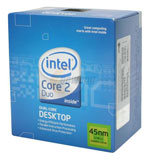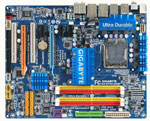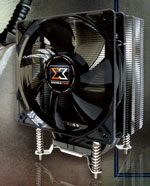Intel Value Midrange
While Intel still owns the very top in CPU performance, the Phenom II has made AMD competitive in the upper midrange to the low high-end. As higher speeds are introduced for Phenom II, that CPU parity will likely move up the CPU scale. That means that midrange to low high-end is now also an area where you can choose Intel or AMD based on the unique features of each platform or expansion capabilities, rather than one brand dominating performance.
The Intel Value Midrange is built around a fast Intel Core 2 Duo CPU. For most applications and gaming, a faster Core 2 Duo is normally a better performance choice than a slower quad-core. CPU intensive applications like video manipulation do benefit from a quad-core CPU, which should be your choice if those applications are important to you. A few recent games are finally taking advantage of quad-core as well.
| Intel Value Midrange PC | ||
| Hardware | Component | Price |
| Processor | Intel Core 2 Duo E8500 Wolfdale (3.16GHzx2, 6MB L2) |
$188 |
| Cooling | XIGMATEK HDT-S1283 120mm Rifle CPU Cooler | $37 |
| Video | SAPPHIRE 100259-1GB Radeon HD 4870 1GB | $230 |
| Motherboard | Gigabyte GA-EP45-UD3P | $137 |
| Memory | OCZ Reaper 4GB (2 x 2GB) DDR2-1066 Dual Channel Kit, | $46 |
| Hard Drive | Seagate Barracuda 7200.11 ST31000333AS 1TB | $110 |
| Optical Drive | LG BD/HD DVD / 16x DVD+/- RW GGC-H20LK | $99 |
| Audio | Creative Sound Blaster X-Fi Xtreme Audio 7.1 Channels 24-bit 96KHz PCI | $50 |
| Case | COOLER MASTER RC-690-KKN1-GP ATX Mid Tower | $80 |
| Power Supply | PC Power & Cooling S75CF 750W SLI CrossFire Ready 80 PLUS Certified | $80 |
| Display | Acer H213H bmid Black 21.5" 5ms HDMI Widescreen 16:9 Full HD 1080P LCD Monitor (1920x1080) | $199 |
| Speakers | Logitech X-540 70 watts 5.1 Speaker - Retail | $79 |
| Input | Microsoft CA9-00001 Black PS/2 Standard Keyboard and Optical USB/PS2 Mouse - OEM | $16 |
| Operating System | Microsoft Vista Home Premium OEM | $99 |
| Bottom Line | $1450 | |
 |
The CPU is one of the fastest Core 2 Duo chips on the market. The E8500 at 3.16GHz is just one step below the fastest Core 2 Duo E8600 which clocks at 3.33GHz. It also overclocks exceptionally well, reaching 4GHz and even higher with relative ease. Because of this OC ability and the value goal of this system build, the E8500 has been matched with components that are also excellent choices for overclocking. The E8500 is plenty fast on its own, but if overclocking interests you this Intel Value Midrange will be ready for action - and ready to overclock to wherever your particular E8500 can go.
 |
The big brother to the UD3R selected in our under $1000 guide is the $137 Gigabyte GA-EP45-UD3P that has a similar feature set but adds a second x16 slot (in place of a PCI slot) for dual x8 CrossFire operation. The board provides an excellent overclocking platform along with great stability. If the second x16 slot is not important to you, we suggest sticking with the UD3R. This P45 chipset motherboard has earned its reputation as a sterling overclocker, while also maintaining excellent stability. It is a good match to the selected Core 2 Duo E8500 or an alternate quad-core Q8200 (2.33GHz).
 |
While the stock Intel cooler is adequate for modestly overclocking a Core 2 Duo, better cooling is needed to push the CPU to its limits. The Xigmatek HDT-D1283 120mm Rifle Cooler did very well in our cooling tests and it is a good match to the E8500. OCZ also markets a similar 120 Rifle cooler and either should work well in this system.
For this Value Midrange system, faster memory with more overclocking headroom was chosen. With the current OCZ rebates some of their best memory is available at truly bargain prices. The choice for the Intel system is an OCZ Reaper 4GB DDR2-1066 (PC28500) kit. With attached heatspreaders and the unique Reaper heatpipes and external heatsink, this 4GB kit is ready for overclocking. The base specs of DDR2-1066 at 5-5-5-18 are also impressive even if you never overclock. Value is good at the normal $76, but with the current $30 rebate the price is an easy-on-the-budget $46.










77 Comments
View All Comments
RonnieJamesDio - Tuesday, January 13, 2009 - link
With the internet alive with horror stories about the Seagate Barracuda 7200.11 1 TB drives failing in massive numbers I would think Anandtech would withhold such blanket approval of this part until the dust settles. I mean, the equivalent WD part costs 10 bucks more on average and in the last storage roundup they couldn't really choose between them!Gary Key - Tuesday, January 13, 2009 - link
We are recommending either the WD Caviar Black 1TB or the Seagate Barracuda 7200.11 ST31000333AS 1TB drives. To be honest, the new Hitachi EK71000 is not bad either if the price comes down. However, we did not and will not recommend the ST31000340AS 1TB drive due to lingering concerns about the quality of the drive at this point.We have requested additional information from Seagate concerning the current problems with the 340AS drive but have not experienced those problems with the 333AS at this point. Seagate did comment to us that we should not expect to see the same problems with the 333AS drives due to a different platter/head design along with optimized firmware.
I have tested four 333AS drives in a Promise NAS unit over the past month by running several VMware applications and other tests that abuse the disks on a constant basis. Temperature readings have ranged from 10C to 50C in a controlled setting and the drives have yet to show a problem when allowed to shutdown for periodic breaks, which have shown to be a major cause of failure on the 340AS drives.
In the meantime, the WD Caviar Black 1TB drive is a favorite of ours and continues to be the drive we utilize in our new test beds.
formulav8 - Tuesday, January 13, 2009 - link
My lord, I would hate to see what you see a Low-End system price to be? This is deinitely not a real world guide from my experience...Jason
JarredWalton - Tuesday, January 13, 2009 - link
Cripes people... it's just a term. Wes put together a $500 to $1000 guide a couple weeks back, so it makes no sense to start the next level guide at $1000. I think you're all intelligent enough to look at both guides and pick and choose parts based on your final budget. You want a $1250 PC? How about taking the $1500 starting price of the base "midrange" systems in this guide and then downgrade a few parts?E8400 saves you $25 or so.
If you don't overclock, you can save $40 on the HSF.
Don't need 1TB of storage? Then how about a 500GB HDD to save $55?
No sound card saves another $50.
DVDR instead of BRD-ROM saves $70.
$80 for speakers that you may not use.
There you have it: the $1450 Intel system is now only $1130, and you can still downgrade the GPU if you're not a serious gamer.
The goal of our buyers' guide has always been to give you a good overview of the market and some reasonable recommendations. There is no "perfect" system that will please everyone, and all the complaints about the definition of "midrange", "entry", "budget", "high-end", "dream", etc. are all missing the point. Are these good systems for $1500 to $2000? Are there any serious flaws? Minor quibbles about whether or not you need that much storage are easily fixed.
Personally, I'd go quad-core Penryn right now over the various other options. That's $100 more than the E8500, but with overclocking you can still get close to the same performance. The http://www.mwave.com/mwave/SkuSearch_v2.asp?SCrite...">Q9450 is still a good buy if you can find it (2x6MB cache is better than the Q9400 and Q9300, not to mention the cache-limited Q8200). I also always recommend getting a better display if at all possible - assuming you didn't do that some time in the past 3-5 years, naturally. A good display can last through many PC upgrades.
7Enigma - Tuesday, January 13, 2009 - link
Completely agree. It's all semantics. 1/3 of the comments are complaining about the wording of what mid-range is? At least bring a real criticism to the discussion.Now can someone comment on the HSF recommended in the Intel mid-range build? I posted an earlier comment and didn't get an answer but the Xigmatek is no where to be seen that I could find on Anandtech. I ended up ordering it along with the C2D 8500 today, but am going to be pissed if there was a better or cheaper (or both? :) option. Could someone link to me the data that the article referenced?
From the article:
"While the stock Intel cooler is adequate for modestly overclocking a Core 2 Duo, better cooling is needed to push the CPU to its limits. The Xigmatek HDT-D1283 120mm Rifle Cooler did very well in our cooling tests and it is a good match to the E8500. OCZ also markets a similar 120 Rifle cooler and either should work well in this system."
Wesley Fink - Tuesday, January 13, 2009 - link
I tested the OCZ variant of the Xigmatek a couple of months ago and found it performed near the top compared to other coolers in its price range. It did not reach the performance levels of the more expensive Thermalright Ultra 120 Extreme, but it was in that ballpark.At the time I was working hard on Digital Camera reviews and news and we decided to can the article and devote more time to other review areas.
The Xigmatek is actually available from others as well, but the price for the Xigmatek brand was the best I could find for this cooler. It is a good match to Core 2 processors since they are not generally super difficult to cool. You will be pleased with the performance.
The Core i7, on the other hand, is something of a cooling challenge (I tried hard to stay positive and not say 'nightmare'). So much so that I will be publishing reviews of Socket 1366 coolers in the nest few weeks. No one is really doing a good job in testing Socket 1366 coolers so we are working on an i7 cooler test platform and testing procedures right now.
Core i7 overclocks well IF you can cool it properly, but it is already pretty hot even at stock speeds with the Intel Retail 1366 HSF.
7Enigma - Wednesday, January 14, 2009 - link
Thank you very much for the reply! I had assumed as much since you mentioned it had been tested but I was going crazy looking again and again at 2008 cooling articles unable to find even the slightest mention of it. $/performance is definitely what I'm shooting for on my latest build and it seems that your recommendation is perfect.My only concern is that it uses pushpins for mounting (or spend an additional $15 (not including shipping) for the backplate). Hopefully it won't be too difficult to mount, but I thank you again for this recommendation.
It may be worthwhile to update this buyers guide to mention that although Anandtech does not have posted data it falls between X and Y on the list for OC'ing, and maybe a 1 sentence mention of installation/noise levels. I'm sure someone else that used the guide for a new build had a similar question as I did.
You guys really are the greatest at not only writing excellent articles but backing up your articles with responses to comments.
JarredWalton - Tuesday, January 13, 2009 - link
I wouldn't be surprised if this is an item that Wes has tested but hasn't had a chance to write up yet. (Or perhaps Matt tested it.) I know from personal experience that the testing is only half the battle when it comes to producing an article. :)takumsawsherman - Tuesday, January 13, 2009 - link
Why the Tuniq tower instead of the Thermalright? The Thermalright seems like a far better cooler based on the reviews on this very site...JarredWalton - Tuesday, January 13, 2009 - link
Price performance... the Ultra 120 eXtreme is a great cooler, but with a fan it's often twice the cost of the Tuniq 120. All that for a difference of perhaps 2-4C? Take the $50 and put it elsewhere if you want better performance.